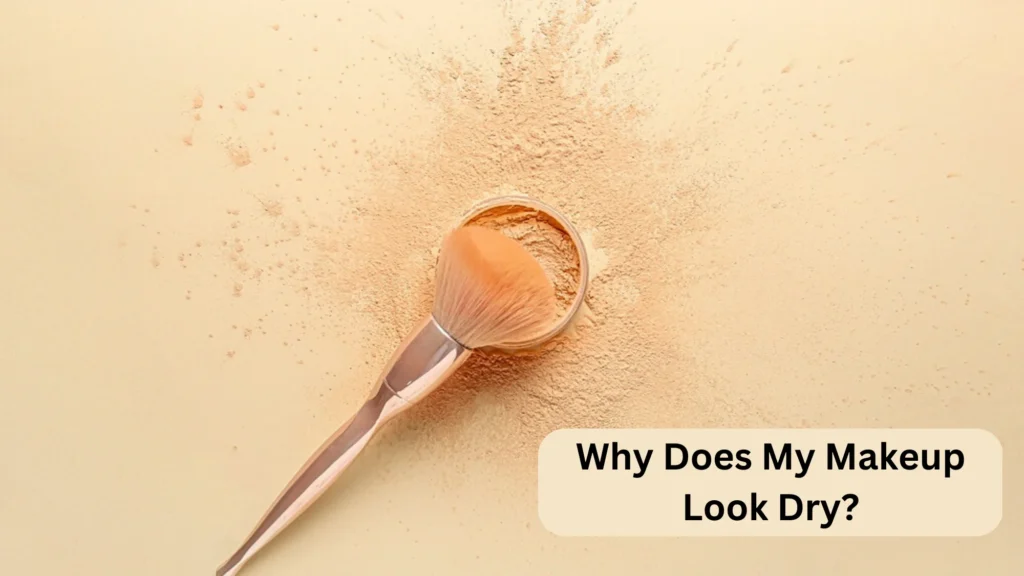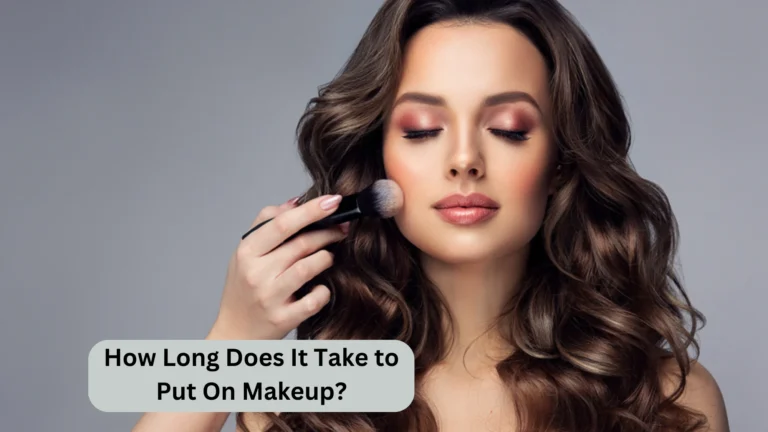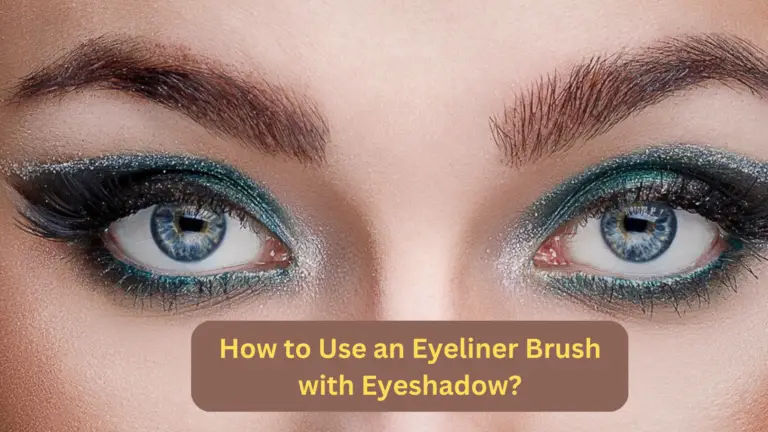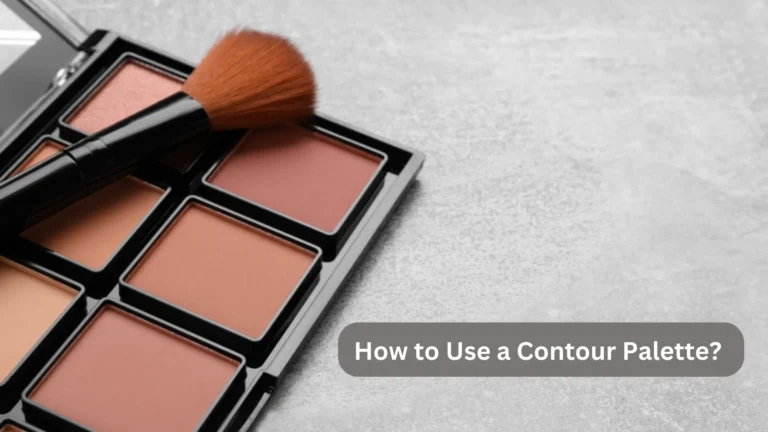Why Does My Makeup Look Dry? 10 Reasons and Preventions!
Makeup has become an official part of our daily routine as it enhances natural features and boosts our confidence. However, despite putting time and effort into achieving a perfect makeup look, many people notice that their makeup appears dry and patchy.
Lack of moisture, using the wrong foundation, and over-applying makeup products can cause makeup to appear dry and cakey.
In this article, I am going to answer the most asked question, Why does my makeup look dry and will give you some preventions to achieve glowy and smooth makeup next time. Keep Reading!
Why Does My Makeup Look Dry? Here are 10 Reasons!
If your makeup looks dry or cakey, it could be due to dehydrated skin, using the wrong foundation, incorrect application, over-powdering, weather, or your skincare routine. Let’s discuss these reasons in detail to know how to achieve a smoother and more hydrated makeup look.
Dehydrated Skin
Dehydrated skin can cause makeup to look cakey because it lacks the necessary moisture and hydration to help the makeup blend seamlessly into the skin. When your skin is dehydrated, it can become flaky, rough, and uneven, making it difficult for makeup products to adhere to the skin and blend properly.
When makeup is applied to dehydrated skin, it can sit on top of the skin instead of blending in, creating a cakey and dry appearance. Additionally, if your skin is dehydrated, it can produce excess oil to compensate for the lack of moisture, which can further contribute to a cakey makeup look.
Wrong Foundation
Using the wrong foundation can cause your makeup to look dry because different foundations are formulated for different skin types. If you use a foundation that is too dry for your skin type, it can exacerbate any dryness you have and make your skin look even drier.
For example, if you have dry skin and you use a foundation that is formulated for oily skin, it can strip away any natural oils on your skin and make your skin look dry and flaky. On the other hand, if you have oily skin and you use a foundation that is too moisturizing, it can make your skin look greasy and the makeup may not last as long.
It’s important to choose a foundation that is formulated for your skin type and to properly moisturize your skin before applying foundation. This can help create a smooth and even base for your makeup, without causing it to look dry or flaky.
Incorrect Application of Products
Incorrect application of makeup products can also cause your makeup to look dry and cakey.
If you apply too much foundation or powder, it can start to look cakey and dry. This is because the excess product can settle into fine lines and creases, emphasizing dry patches and making your skin look uneven.
Using the wrong tools to apply your makeup can also cause it to look dry and cakey. For example, if you use a brush that is too stiff or dense to apply your foundation, it can leave streaks and emphasize dry patches.
Layering products that are incompatible with each other can also cause your makeup to look dry and cakey. For example, if you use a water-based primer and an oil-based foundation, they may not blend well together and can start to look cakey and patchy.
Over-Use of Setting Powder

Overusing setting powder is a common mistake that can cause makeup to look dry and cakey. Many females ask me this question, Why powder makes my face dry? It is because they are usually overusing setting powder.
Setting powder is typically used to set liquid or cream products, such as foundation or concealer, and to prevent them from creasing or moving from place. However, when too much setting powder is applied, it can start to absorb excess moisture and natural oils from the skin, making it appear dry, grey, and cakey.
Not Following Skincare Routine
Your skincare routine can also have an impact on how your makeup looks, and if you’re not properly moisturizing your skin, it can cause your makeup to look dry and cakey.
If you’re not properly cleansing your skin, it can lead to a buildup of dirt and oil on your skin, which can cause your makeup to look cakey and uneven. Make sure to cleanse your skin thoroughly before applying makeup.
Moisturizer is an essential step in any skincare routine, as it helps to hydrate and nourish the skin, creating a smooth and even base for makeup application. If you skip moisturizer, your skin can look dry and flaky, which can make your makeup look cakey.
Another common question people ask is, “I have oily skin but my makeup looks dry why is that?” It is because using a moisturizer that is not suitable for your skin type can cause your makeup to look dry and cakey. For example, if you have oily skin and you use a heavy moisturizer, it can make your skin look greasy and your makeup may not last as long.
Using Matte Foundation
If you are thinking, “Why does my skin flake when I put makeup on?” The reason can be using a matte foundation. Using a matte foundation can cause your makeup to look dry and patchy, especially if your skin is already dry or you’re not properly prepping your skin before applying the foundation.
Matte foundations are designed to create a matte, shine-free finish on the skin, which can be great for those with oily skin. However, if you have dry or combination skin, a matte foundation can emphasize any dry patches and make your skin look even drier.
Additionally, if you’re not properly prepping your skin before applying a matte foundation, it can settle into fine lines and creases, making your makeup look patchy and uneven.
Not Using Primer Before Applying Foundation
Primer helps to create a smooth and even surface on your skin for a foundation to be applied. If you skip this step, any texture on your skin, such as fine lines, pores, or dry patches, can be emphasized by the foundation, making it look cakey.
Some people have naturally oily skin, and without a primer, the oils on your skin can break down your foundation causing it to look cakey and uneven. Primer helps your foundation to last longer by creating a barrier between your skin and the foundation. Without a primer, the foundation may break down faster, leading to a cakey appearance.
Using Old Products
Using old makeup products can cause your makeup to look dry and cakey for a few reasons. Over time, makeup products can break down and lose their effectiveness. This can cause the formula to become dry and difficult to apply, leading to a cakey appearance on the skin.
Old makeup products can also become a breeding ground for bacteria, which can cause irritation and inflammation of your skin often leading to dryness and flakiness. Moreover, as makeup products become old, the color can change, which can cause the makeup to look patchy and cakey on the skin.
Medical Conditions
If you are one of them that complains “No matter what I do my foundation looks bad” then maybe the problem is not in the products. Certain medical conditions can cause makeup to look dry and cakey on the skin too. If you have a medical condition that is causing your skin to be dry or flaky, it’s important to work with your healthcare provider or dermatologist to find an appropriate treatment plan that can help alleviate your symptoms and improve the appearance of your skin. Let’s discuss which medical conditions cause makeup to look cakey:
- Eczema is a skin condition that can cause dry, itchy, and inflamed skin. If you have eczema, your skin may be more prone to dryness and flakiness, which can make your makeup look cakey and patchy on the skin.
- Psoriasis is a chronic autoimmune condition that causes red, scaly patches on the skin. These patches can be dry and flaky, which can cause makeup to look cakey and uneven.
- Rosacea is a skin condition that causes redness and inflammation on the face. If you have rosacea, your skin may be more sensitive and prone to dryness, which can make your makeup look dry.
- Some medications can cause dryness and flakiness on the skin, which can make your makeup look cakey. For example, acne medications like isotretinoin can cause dryness and flakiness, as can certain medications used to treat autoimmune conditions.
Weather Conditions
For those wondering, Why does my makeup look dry? The reason can be a harsh climate. Weather conditions can contribute to makeup looking dry on the skin, especially during colder months when the air is drier. Dry weather can cause the skin to become dehydrated and flaky, making makeup look cakey and emphasized on the skin. In addition, hot and humid weather can cause excess sweating, which can lead to makeup melting off or becoming patchy.
How to Avoid Dry Makeup Look?
For those who keep asking me, How do I stop my foundation from flaking? Well, now I will explain what you should do to avoid dry and patchy makeup. Dry patches look terrible on the skin, especially when they appear after applying foundation. These patches can make your skin look flaky, cakey, and uneven. Luckily, there are several ways to avoid dry patches after foundation and achieve a smoother, more flawless finish. Let’s discuss them one by one:
Always Cleanse Your Face
When you cleanse your face, you remove any dirt, oil, and dead skin cells that can accumulate on your skin, which can prevent makeup from adhering properly and cause it to look dry and patchy. Cleansing also helps to create a smooth, hydrated surface for makeup application, which can help it to last longer and look more radiant.
To properly cleanse your face, start by choosing a gentle, hydrating cleanser that is suitable for your skin type. Wet your face with warm water, and then apply the cleanser in circular motions, focusing on areas that tend to be dry such as your cheeks and forehead. Be sure to rinse your face thoroughly with water and pat it dry with a clean towel.
After cleansing, apply a lightweight, hydrating moisturizer to your face to further hydrate and nourish your skin. This will help to prevent your makeup from looking dry and flaky and keep it looking fresh and radiant throughout the day.
Use a Hydrating Moisturizer
Using a hydrating moisturizer is essential for preventing dry makeup. When your skin is dry, it can cause your makeup to look flaky and uneven, and it can also make it more difficult to blend and apply smoothly.
A hydrating moisturizer will help to nourish and hydrate your skin, creating a smooth and supple surface for your makeup to adhere to. It will also help to prevent moisture loss, which can occur due to environmental factors such as cold weather, indoor heating, or air conditioning.
When choosing a moisturizer, look for one that is specifically designed for your skin type. For example, if you have dry skin, look for a moisturizer that is rich and nourishing, while those with oily or combination skin may prefer a lighter, oil-free formula.
Apply your moisturizer after cleansing your face, and allow it to fully absorb into your skin before applying any makeup. This will help to create a smooth and hydrated base for your makeup, ensuring that it looks fresh and flawless all day long.
Use a Hydrating Primer
Using a hydrating primer can help prevent dry makeup. Primers act as a barrier between your skin and makeup, providing a smooth and even base for your foundation or other makeup products to adhere to. They also help to hydrate your skin, making it less likely to dry out from the makeup.
By creating a smooth surface, the primer can help the makeup glide on more easily, reducing the amount of rubbing and pulling on your skin, which can also contribute to dryness. Additionally, some primers contain ingredients like hyaluronic acid or glycerin, which can help to attract and retain moisture in the skin, further preventing dryness.
Use a Lightweight Foundation
A lightweight foundation helps in preventing dry and cakey makeup. Heavier foundations can sometimes settle into fine lines and dry patches on the skin, making them more noticeable and accentuating any dryness or texture issues.
Lightweight foundations, on the other hand, tend to have a more natural finish and can be easier to blend into the skin, creating a more seamless look. Additionally, many lightweight foundations are formulated with hydrating ingredients like hyaluronic acid or glycerin, which can help to moisturize the skin and prevent dryness.
Use a Damp Beauty Sponge

Using a damp sponge can be an effective way to avoid a cakey makeup look. When you apply makeup with a dry sponge or brush, it can sometimes pick up excess product and leave a heavy layer on the skin, which can contribute to a dry, cakey look. Using a damp sponge, on the other hand, can help to evenly distribute the product, making it easier to blend and creating a more natural finish.
The dampness of the sponge can help to add moisture to the skin, which can help to prevent dryness and keep the makeup looking fresh throughout the day. When using a damp sponge, it’s important to make sure that it’s not too wet, as this can also affect the way the makeup applies and wears. You can dampen the sponge with water or a facial mist before use, and make sure to squeeze out any excess moisture before applying makeup.
Apply Makeup In Thin Layers
When you apply a thick layer of makeup, it can sometimes settle into fine lines and creases, creating a dry, cakey appearance. By applying your makeup in thin layers, you can build up coverage gradually and ensure that it blends seamlessly into the skin, without emphasizing any dryness or texture issues.
When makeup artist says, “Less is more” they are absolutely right. Applying a thin layer of makeup can prevent patchiness. Also, applying makeup in thin layers can help to make it last longer, as each layer has a chance to dry and set before the next one is applied.
Set With a Hydrating Mist
Setting your makeup with a hydrating mist can help prevent dry makeup. Setting sprays or mists can help to lock in your makeup and make it last longer, but some formulas can be drying to the skin.
Using a hydrating mist as your setting spray can help to counteract this and add moisture back into the skin, preventing it from looking dry or cakey. Additionally, hydrating mist contains ingredients like glycerin, hyaluronic acid, or aloe vera, which can help to soothe and hydrate the skin, making it look more plump and healthy.
Avoid Over-Powdering
Over-powdering can also emphasize fine lines, wrinkles, and texture issues on the skin, making them more noticeable. Instead of applying powder all over your face, focus on setting areas where you tend to get oily or where your makeup tends to crease, such as the T-zone, under the eyes, or around the mouth.
You can also try using a finely milled, translucent powder that won’t add extra color or texture to the skin. Another option is to use a powder foundation or a tinted setting powder that can add a touch of coverage while still setting your makeup in place. It’s important to experiment and find the right balance of powder for your skin type and makeup look.
Use a Hydrating Face Mask
Some face masks are specifically formulated to hydrate and plump the skin, making it look more youthful and radiant. By using a hydrating mask before makeup application, you can help to prep the skin and create a smooth, hydrated base for your makeup to adhere to. This can help prevent your makeup from settling into fine lines and dry patches, and make it look more natural and fresh.
However, it’s important to choose a mask that’s appropriate for your skin type and concerns, as some masks can be drying or irritating to certain skin types. You should also make sure to remove the mask thoroughly and apply your moisturizer and primer before applying makeup to ensure that the skin is properly hydrated and prepped for makeup application.
Choose the Right Makeup Brushes
Choosing the right makeup brushes can help prevent a dry makeup look by ensuring that the products are applied evenly and smoothly without emphasizing any dry patches or texture on the skin.
Look for brushes with soft, synthetic bristles. Synthetic bristles tend to be softer and less likely to cause irritation, while also being more hygienic than natural bristles. Soft bristles will also help prevent any tugging or pulling on the skin, which can cause dryness.
Choose brushes with a fluffy, rounded shape. Fluffy, rounded brushes are great for applying powders, such as blush or bronzer, without causing any dryness or patchiness on the skin. The fluffy shape helps to diffuse the product evenly and create a seamless finish.
Avoid brushes with a flat or dense shape. Flat or dense brushes tend to pick up a lot of product and can easily deposit it in one spot, which can create a dry, cakey look. If you do use a flat brush, make sure to tap off any excess product before applying it to the skin.
Exfoliate Your Skin Weekly
Exfoliating your face once or twice a week can help prevent a dry makeup look by creating a smooth, even surface for makeup application. When dead skin cells accumulate on the surface of the skin, they can create a rough, uneven texture that can make makeup look patchy or cling to dry areas.
By exfoliating the skin regularly, you can remove these dead skin cells and promote cell turnover, which can improve the texture and overall appearance of the skin. This can help makeup go on more smoothly and evenly, and prevent it from dry patches or rough texture on the skin.
Wrapping Up
All in all, for those wondering, why does my makeup look dry? Some common factors include a lack of proper skin care, using the wrong makeup products, and applying makeup incorrectly causes makeup to look dry and patchy. However, by taking steps such as hydrating the skin with moisturizer, using lightweight and hydrating makeup products, and avoiding over-powdering, it’s possible to achieve a smooth and flawless makeup application without dryness or texture on the skin. With a few adjustments to your skincare and makeup routine, you can achieve a fresh and natural-looking makeup finish that looks hydrated and glowy!
Also Read: How to Use an Eyeliner Brush with Eyeshadow? A Step-By-Step Guide!
FAQs
Why Does My Makeup Look Dry Under My Eyes?
If your makeup looks dry under your eyes, it could be due to not using primer or moisturizer before applying concealer, using heavy and thick concealers, not setting the concealer with powder, using too much powder, or not exfoliating regularly.
Why Does My Makeup Look Dry Around My Mouth?
Cold, dry air can also contribute to dryness around the mouth and make makeup look dry and flaky. Also, not properly moisturizing before putting concealer around the mouth can also cause the area to dry.
Why Does My Makeup Look Dry On My Nose?
Some people may naturally have drier skin on their noses, which can make makeup look dry and cling to any dry patches. Another reason is Using a heavy and thick foundation or concealer around your nose.
How to Prep Dry Skin For Makeup?
To prep dry skin for makeup, start by moisturizing your skin with a hydrating moisturizer or facial oil. Then, apply a hydrating primer to create a smooth and even base for your makeup. Use a lightweight and hydrating foundation or tinted moisturizer, and apply it with a damp sponge for a natural-looking finish.







